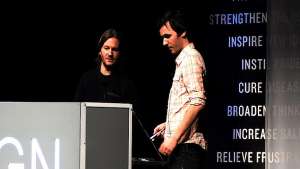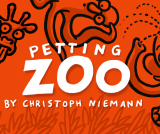When you’re knee-deep in all that’s trendy and chic at the Design Indaba, there’s something deeply reassuring about a man who is totally unpretentious. Especially if he’s a world-class, world-famous designer. Ivan Chermayeff is clear and simple — and witty in an understated kind of way. He’s also the man who has designed many of the world’s most recognised logos and brands: National Geographic, Mobil, Xerox, Chase Bank and a whole library of others in his 50 years in the industry.
By scheduling Chermayeff as the first speaker of this year’s indaba, the organisers reminded the delegates what great design is all about. It’s not (all) about being totally cool and rippingly cutting edge (although that is what the erudite and self-effacing Chermayeff is, of course). It’s about, as Chermayeff says, making the “visual connection”.
Beginning with something quite personal, Chermayeff went through a series of collages, which, he says, he’s been making “forever”. Stamps, envelopes, his children’s artwork, footsteps in Indian ink, drive-in theatres, torn papers; the world is a treasure trove of rubbish. “All this nonsense work makes me think about connections,” he explains. I guess that’s how you get to make long-lasting, classic design trademarks like:
Grey
This was designed about 25 years ago. “The ligature is totally unnecessary. But I had to do something.”

Mobil
Designed in 1963, this is still in use today. “We made the ‘o’ red. It allows all kinds of things to happen … You can take enormous liberties when something becomes part of your life, when it is all around you. It’s things like this that make life a lot of fun.”

HarperCollins
This was the result of the merging of two publishers, Harper & Row, who had a “complicated torch” as their logo, and Collins, who had a fountain.
Chermayeff says he doesn’t use a computer or even own a cellphone. It’s almost obvious that this would be so. His designs and collages are so strikingly simple. There’s no noise, no interference; just clarity of thought.
There’s no denying the coolness, though. Try to tell me that designing a five-storey shark, creating pixels with blue and white Portuguese tiles, isn’t the epitome of coolness. And cleverness. And, of course, playfulness. Even host Nkhensani Nkosi was sporting a Mohican.
Each of the designers on the first day spoke about playing, about having fun. Airside, a trio of British designers, spoke about living their dreams. Alex Maclean, Fred Deakin and Nat Hunter said they started their design business 10 years ago because they were sick and tired of being told what to do by “rubbish idiots”. They’re now the gainful, successful employers of 13 studio employees as well as about 40 freelancers. They’re successful, cool and clever enough to still be able to make their work play (as well as pay buckets, I imagine).
Running through 10 years of work, they showcased projects like the Stitches, which is an adoption programme for little woolly creatures. This, they say, is all about studying the interaction and reaction of people. This woolly love has created the context for “twentysomething British guys and thirtysomething Japanese women” to form their own communities, interacting digitally. I guess Chermayeff may argue that this “nonsense work” is also about creating connections.
With artful joy, lines and letters, the work of Japanese designer Hideki Inaba was so beautiful in its sense of play that it made the audience gasp: bloodied, disappearing red letters; playful letters of the alphabet; elegant and beautiful lines streaking across the screen.
Oh, and then there was Iceland and Germany’s super-chilled, super-self-deprecating Karlssonwilker. Eish. Just when I thought design (and designers) couldn’t get cleverer or cooler. They distributed a series of 10 posters chronicling their journey, 10 Days in South Africa.
And, thank God, two female designers: Oona Scheepers, an automotive designer, and Dutch food designer Marije Vogelzang, whose stylish interpretation of food and eating blew off the top of my head. I’ll have to write about them in another posting, but they somehow manage to encapsulate what the Design Indaba is about: filling your head (and your heart) to bursting point. It’s inspiring, awesome and so freaking global. I’m playing designer dot-to-dot and loving it.



















